Canadian economic accounts
Archived Content
Information identified as archived is provided for reference, research or recordkeeping purposes. It is not subject to the Government of Canada Web Standards and has not been altered or updated since it was archived. Please "contact us" to request a format other than those available.
Related subjects
-
[an error occurred while processing this directive]
Real gross domestic product (GDP) advanced 0.9% in the third quarter, after declining 0.1% in the second quarter. Increased demand for exports led third quarter GDP growth. On a monthly basis, real GDP by industry increased 0.2% in September.
Consumer spending on goods and services rose 0.3% in the third quarter, slightly below its second quarter gain of 0.5%.
Government expenditures on goods and services grew 0.2%, similar to the previous quarter (+0.3%).
Housing investment strengthened to 2.6%, well above the second quarter pace of 0.4%. This was the strongest growth since the first quarter of 2010.
However, business investment in plant and equipment fell 0.9%, the first quarterly decline since 2009.
Final domestic demand has been slowing throughout 2011 compared with 2010. On average, it has recorded quarterly growth of 0.5% since the start of the year. This was down from the average quarterly growth of 1.1% over the same period of 2010.
Both the goods-producing industries (+1.4%) and the service industries (+0.6%) grew in the third quarter. The energy sector led the way and notable increases were also seen in manufacturing, construction, wholesale trade and the transportation and warehousing sector.
The energy sector increased 2.6% in the third quarter, as crude oil extraction more than recovered from a period of maintenance activities and production difficulties at some oil fields. Manufacturing output rose 0.9%, mostly on increased production of transportation equipment, machinery and chemicals. There were widespread gains in wholesale trade (+1.4%). The transportation and warehousing sector grew 1.3%, partly as a result of the end of labour disputes in postal services.
Note to readers
The historical revision to the Canadian National Accounts, originally scheduled for release in June 2012, has been delayed to early fall 2012. This accommodates data users who indicated that they needed more time to prepare for the conceptual, methodological and classification changes associated with the historical revision.
A new schedule of releases has been posted on the National economic accounts website. Additional information will be posted as it becomes available.
For more information, contact the information officer (csna-info-scnc@statcan.gc.ca).
Percentage changes for expenditure-based and industry-based statistics (such as personal expenditures, investment, exports, imports and output) are calculated from volume measures that are adjusted for price variations. Percentage changes for income-based and flow-of-funds statistics (such as labour income, corporate profits, mortgage borrowing and total funds raised) are calculated from nominal values; that is, they are not adjusted for price variations.
There are four ways of expressing growth rates for gross domestic product (GDP) and other time series found in this release.
1. Unless otherwise stated, the growth rates of all quarterly data in this article represent the percentage change in the series from one quarter to the next, such as from the second quarter to the third quarter of 2011.
2. Quarterly growth can be expressed at an annual rate by using a compound growth formula, similar to the way in which a monthly interest rate can be expressed at an annual rate. Expressing growth at an annual rate facilitates comparisons with official GDP statistics from the United States. Both the quarterly growth rate and the annualized quarterly growth rate should be interpreted as an indication of the latest trend in GDP.
3. The year-over-year growth rate is the percentage change in GDP from a given quarter in one year to the same quarter one year later, such as from the third quarter of 2010 to the third quarter of 2011.
4. The growth rates of all monthly data in this article represent the percentage change in the series from one month to the next, such as from August to September 2011.
Growth of gross domestic product outpaces that of final domestic demand
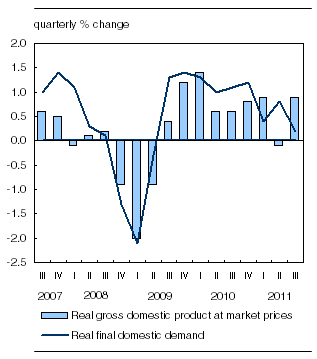
Chart description: Growth of gross domestic product outpaces that of final domestic demand
Expressed at an annualized rate, real GDP expanded 3.5% in the third quarter, following a 0.5% decline in the second quarter. By comparison, real GDP in the United States grew 2.0% in the third quarter.
Contributions to percentage change in real gross domestic product, third quarter 2011
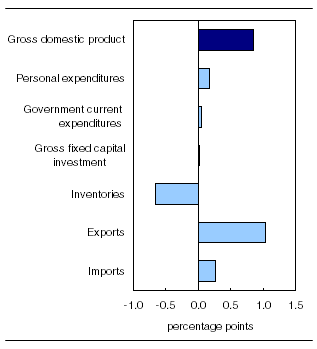
Exports rebound
Exports advanced 3.4% in the third quarter after declining in the second quarter. Exports of goods increased 4.1%, while exports of services fell 0.7%.
The main contributors to the increase of goods were industrial goods and materials, and machinery and equipment. On the other hand, forestry (-0.9%) and automotive products (-0.1%) declined. This was the fourth decrease in the last five quarters for automotive products.
Exports rebound
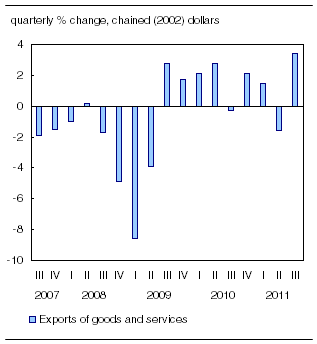
Chart description: Exports rebound
In the third quarter, demand for exports of services declined following a 3.1% gain in the second quarter. Increases in transportation, travel and government services were more than offset by declines in commercial services and financial intermediation.
Demand for imports fall
Imports of goods and services fell 0.8% in the third quarter, the first quarterly decline this year. All major categories of goods imports declined except for automotive products (+5.6%) and forestry products (+1.1%). Machinery and equipment (-3.0%) and energy products (-6.3%) contributed the most to the decline in goods imports in the third quarter. Similarly, most major categories of services imports fell, led by declines in commercial services (-2.6%) and travel (-2.0%).
Consumer spending slows
Consumer spending on goods and services slowed to 0.3% in the third quarter, from 0.5% in the second quarter. In the third quarter, consumers reduced their purchases of durable goods (-0.4%). However, purchases of semi-durable goods (+1.0%), non-durable goods (+0.4%), as well as services (+0.3%) increased.
Purchases of new and used motor vehicles fell 1.2%, the third quarterly decline in a row. Spending on furniture, carpets and other floor coverings also fell in the third quarter.
The increase in expenditure on services reflects the rise in spending on purchased transportation, recreational services and financial, legal and other services. Purchased transportation has been increasing steadily since the second quarter of 2009.
Clothing and footwear purchases (+1.5%) were also up in the quarter.
Housing demand picks up
Housing investment advanced 2.6% in the third quarter, a much faster pace than in the second quarter (+0.4%). Ownership transfer costs related to housing resale activity increased 1.5% after falling in the second quarter. Renovation activity rose 1.7% following a gain of 0.2% in the previous quarter. New housing construction rose 3.9%, matching the pace in the previous quarter.
Business investment in plant and equipment falls
Business investment in plant and equipment fell 0.9% in the third quarter, following six consecutive quarterly increases.
Business investment in non-residential structures increased 1.1% in the third quarter, after falling 0.2% in the second quarter. Business investment in engineering structures grew 2.1%, while investment in buildings fell 1.7%, the second decline in a row.
Business investment in machinery and equipment fell 2.9%, after an unusually strong second quarter increase of 7.3% that was mainly because of the arrival of a natural gas platform. With the exception of agricultural machinery, software and automobiles, investment in all major categories of machinery and equipment fell. This was the first decline in machinery equipment since the fourth quarter of 2009.
Business inventories register moderate buildup
There was a buildup in business inventories of $10 billion in the third quarter. Retail trade inventories made up almost half of this increase. This was in contrast to the second quarter buildup of $21 billion, when manufacturers and wholesalers had built up durable goods inventories.
Economy-wide income expands
Nominal GDP expanded 1.1% in the third quarter, more than double the growth recorded in the previous quarter. Corporate profits grew 4.2% after declining 2.0% in the second quarter.
Labour income grew 0.7% in the third quarter. Wages and salaries increased in both goods-producing and services industries. Personal disposable income remained unchanged in the third quarter compared with growth of 0.8% in the previous quarter.
The personal saving rate was 3.5% in the third quarter, down from 4.1% in the second quarter. The national saving rate was 6.3%, and has remained above 6% since the beginning of the year.
Purchasing power increased
Canada's real gross domestic income, a measure of purchasing power, increased 0.6% in the third quarter. Canada's terms of trade, which measure export prices relative to import prices, declined 0.8%.
The price of goods and services produced in Canada rose 0.3% in the third quarter, half of the pace in the second quarter, as export prices slowed to 0.2% from an increase of 1.7% in the second quarter. The price of final domestic demand categories rose 0.5% compared with 0.3% in the second quarter.
Financial flow accounts: Demand for funds softens
Total funds raised by domestic non-financial sectors totalled $221 billion (seasonally adjusted at annual rates) in the third quarter, down from $263 billion in the second quarter. Financing activity was notably lower in both the non-financial corporations and other levels of government sectors.
Financing activity in non-financial private corporations slowed to $48 billion in the third quarter, down from $71 billion in the second quarter. Most of the financing during the quarter occurred via equities and mortgages, while bond issues and loans were appreciably lower.
Federal government short-term paper issues were significantly higher, while bond issues were lower. Other levels of government borrowed less in the third quarter compared with the second quarter.
Overall household borrowing (mortgages, consumer credit and loans) also slowed, decreasing from $97 billion in the second quarter to $91 billion in the third quarter. The decrease in loans and consumer credit more than offset the increase in mortgage borrowing.
In the third quarter, financial institutions invested heavily in fixed income securities, notably bonds primarily related to asset-backed securities. In comparison, net new loan issuances slowed considerably in the quarter.
Non-residents purchased significant amounts of Canadian Treasury bills in the third quarter. However, the third quarter also marked the lowest quarterly acquisitions of Canadian bonds by non-residents in three years.
Gross domestic product by industry, September 2011
Real GDP rose 0.2% in September, following 0.4% increases in both August and July. Output in the goods-producing industries rose 0.5% in September as increased activity was recorded in manufacturing, mining and oil and gas extraction as well as utilities and construction. The service sector edged up 0.1%, with advances in retail trade, transportation and some tourism-related industries. Conversely, the finance and insurance sector retreated. The public sector (public administration, education and health care) was essentially unchanged for a second month in a row.
Real gross domestic product rises in September
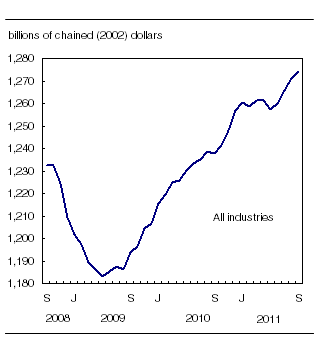
Chart description: Real gross domestic product rises in September
Manufacturing output rebounded 0.6% in September from a 0.2% decline in August. Manufacturers of durable goods increased production by 1.7%. Significant increases were recorded in manufacturing of machinery and, to a lesser extent, furniture and related products, non-metallic mineral products as well as fabricated metal products. The decline in food manufacturing accounted for most of the 0.8% decrease in non-durable goods manufacturing.
Retail trade advanced 0.7%, largely because of increased activity at new car dealers, food and beverage stores, and electronics and appliance stores. Wholesale trade edged up 0.1%.
Output in the energy sector (+1.1%) progressed for a fourth consecutive month. Oil and gas extraction, electric power generation and support activities for mining and oil and gas extraction accounted for most of the growth. Increases in other metal ore mining (which includes uranium) and refineries contributed to a lesser extent.
Construction continued to rise, up 0.2% in September. Engineering and repair work as well as residential building construction increased while non-residential building construction declined. The output of real estate agents and brokers increased 3.2%.
The finance and insurance sector fell 1.0% after rising 1.4% in August. Most of the decrease came from a lower volume of trading on the stock exchanges, following strength in August and reduced sales of mutual funds. Output of insurance carriers was up 0.6%.
Main industrial sectors' contribution to the percent change in gross domestic product, September 2011
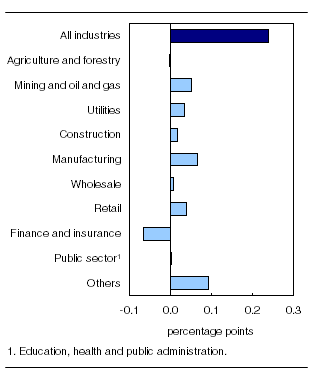
Products, services and contact information
Detailed analysis and tables
The National economic accounts module, accessible from the Key resource module of our website, features an up-to-date portrait of national and provincial economies and their structure.
Additional tables and links to other releases from the national accounts can be found in the third quarter 2011 issue of Canadian Economic Accounts Quarterly Review, Vol. 10, no. 3 (13-010-X, free). This publication is now available from the Key resource module of our website, under Publications. This publication will be updated on December 13, at the time of the release of the National balance sheet accounts. Revised estimates of the Income and expenditure accounts for the first quarter and second quarter of 2011 have been released, along with those for the third quarter of 2011. These estimates incorporate new and revised source data and updated estimates of seasonal patterns.
Gross domestic product by industry
Available on CANSIM: table 379-0027.
Definitions, data sources and methods: survey number, including related survey, 1301.
The September 2011 issue of Gross Domestic Product by Industry, Vol. 25, no. 9 (15-001-X, free), is now available from the Key resource module of our website, under Publications.
Data on gross domestic product by industry for October will be released on December 23.
For more information, or to order data, contact the information officer (toll-free 1-800-887-4623; 613-951-4623; iad-info-dci@statcan.gc.ca). To enquire about the concepts, methods or data quality of this release, contact Allan Tomas (613-951-9277), Industry Accounts Division.
Income and expenditure accounts
Available on CANSIM: tables 026-0009, 380-0001 to 380-0017, 380-0019 to 380-0035, 380-0056, 380-0059 to 380-0062 and 382-0006.
Definitions, data sources and methods: survey numbers, including related surveys, 1901 and 2602.
The third quarter 2011 issues of National Income and Expenditure Accounts: Data Tables, Vol. 4, no. 3 (13-019-X, free), and Estimates of Labour Income: Data Tables, Vol. 4, no. 3 (13-021-X, free), are also now available from the Key resource module of our website, under Publications.
For more information, or to enquire about the concepts, methods or data quality of this release, consult the Guide to the Income and Expenditure Accounts (13-017-X, free), or contact the information officer (613-951-3640; iead-info-dcrd@statcan.gc.ca), Income and Expenditure Accounts Division.
Financial flow accounts
Available on CANSIM: tables 378-0015 to 378-0048.
Definitions, data sources and methods: survey number 1804.
The third quarter 2011 issue of Financial Flow Accounts: Data Tables, Vol. 4, no. 3 (13-020-X, free), is also now available from the Key resource module of our website, under Publications.
For more information, or to enquire about the concepts, methods or data quality of this release, contact the information officer (613-951-3640; iead-info-dcrd@statcan.gc.ca), Income and Expenditure Accounts Division.
- Date modified:
